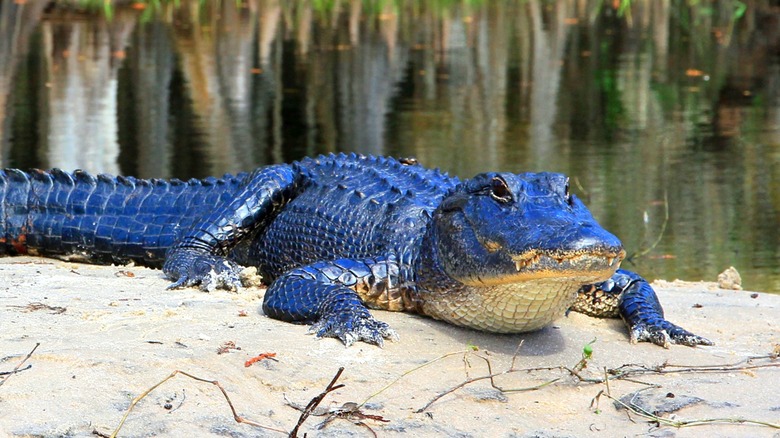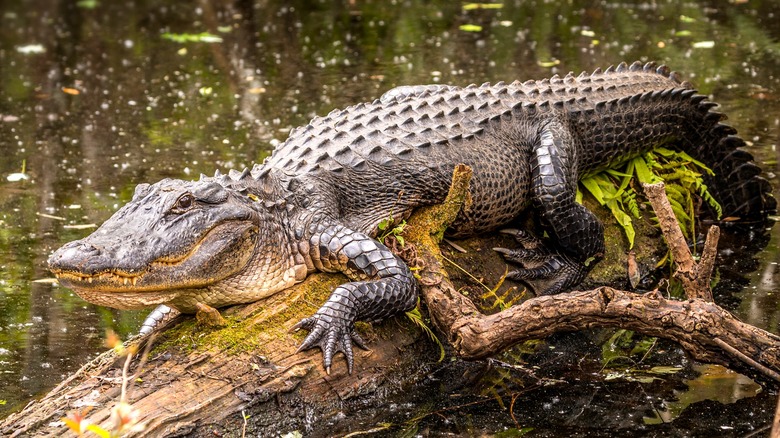The 5 Most Alligator-Filled Destinations In All Of Florida
Florida has the second largest alligator population in the United States, with more than 1.3 million of the fanged reptiles residing across the peninsula's many lakes, swamps, rivers, reservoirs, canals, and golf courses. Louisiana has the most alligators, but some would argue that Florida's are housed in the more dramatic scenery, namely the awesome Everglades National Park.
Millions of people visit Florida every year to see alligators in their natural habitat, and many are attracted by the inherent danger of these powerful animals, which can weigh over 1000 lbs. It is correct to respect these animals while recognizing that Floridians coexist peacefully with the inscrutable scaled beasts. Injuries are rare and deaths are rarer, but it's still best to avoid swimming in alligator infested waters. The Florida Fish and Wildlife Conservation Commission advises against feeding alligators and recommends to keep safe distances at all times and swim only in designated swimming areas during daylight hours. The National Park Service makes the point clearest with signs reading "dangerous alligators are created by people."
Florida's most alligator-filled spots are ranked according to the number of alligators counted — some populations are likely much greater at each lake and park.
Lake Kissimmee — 2,065 alligators
Lake Kissimmee is located in Central Florida near the underrated Kissimmee Prairie Preserve State Park. The 5,930-acre lake is the centerpiece of Lake Kissimmee State Park, as it is popular with campers, hikers, and kayakers. Swimming is not so popular owing to the approximately 2,065 alligators in Kissimmee, but some locals enjoy a dip and insist that alligators won't bother you if you don't bother them.
There are 19 miles of trails — 13 for hikers, six for horse riders — and they are home to numerous animals including white tail deer, bobcat, Sherman's fox squirrel, grey fox, and numerous birds including turkey, scrub jay, and the iconic American bald eagle.
Tourist infrastructure is well-established at Lake Kissimmee. There is a camp store open from April to November that offers kayak and canoe rental for the 10-mile Buster Island Paddling Trail, which is ideal for alligator spotting. There are also 54 full-facility campsites and a youth camping area with room for 50 people.
Lake Jesup — 2,414 alligators
Northeast of Orlando, Lake Jesup is said to have the densest alligator population in Florida owing to conservation efforts during the central region's rapid development. "Back in the '60s and '70s, alligators were on the endangered species list, so you could not hunt them or kill them," explained hovercraft captain Tim Harrold. "They had to relocate all the alligators, and this is where they brought them."
Fifty years as a state-wide refuge has made Lake Jesup one of Florida's best places to observe alligators. Visitors can start on foot and follow trails through dramatic weeping cypress trees and open swamplands before boarding one of the state's famous airboats, which cost $38 plus tax.
Authorities have counted 2,414 alligators at Lake Jesup, but Tim Harrold suspects there could be up to 12,000 of them. The alligators have many peers and prey here, too, including over 90 species of birds that nest on Bird Island, a 30-acre site teeming with egrets, herons, and bald eagles.
Lake George — 2,660 alligators
Lake George is a 43,471-acre setting on the eastern edge of Ocala National Park, about 70 miles north of Orlando and near one of the Florida's most underrated state parks. It is the second largest lake in the state and home to many animals including mullet, striped bass and at least 2,660 alligators sunning on its banks.
Several features distinguish Lake George. The most obvious is the lack of vegetation beyond reeds and eelgrass near the shoreline; there is no foliage at all along the lake's consistent depths of 10-12 feet. Another is the lake's brackish water, saline enough to host blue crabs and even Atlantic stingrays. Perhaps the most appealing feature is Silver Glen Springs, one of Lake George's four tributaries. Silver Glen's stunning waters are perfect for clear bottom kayaking, which allows you to get in every nook and cranny in search of monkeys, manatees, and other interesting species.
Lake Okeechobee — 9,308 alligators
Lake Okeechobee, often called Florida's "inland sea," is the largest freshwater lake in the state, covering some 750-square-miles. Okeechobee is about a 50-mile drive from West Palm Beach and located near Clewiston, known as "America's sweetest town" owing to its sugarcane industry. Alligators aren't too keen on sugar, but they do enjoy the many deer, boar, birds and other animals that live here. The combination of the region's rich biodiversity and sheer size cause it to host some 9,308 alligators, although estimates run as high as 30,000.
Lake Okeechobee may teem with alligators but it attracts scores of locals and tourists seeking Florida's timeless natural wonders. Hikers embark on the 110-mile Lake Okeechobee Scenic Trail while anglers cover the south, west, and north portions of the lake in search of big bass and bluegills. Airboats cut through the Okeechobee waters, too, passing hundreds and thousands of alligators.
Everglades National Park - 200,000 alligators
With some 200,000 residents, Everglades National Park is home to the largest alligator population in Florida. The park, spanning 1.5-million acres, is a vast subtropical eco-system that includes swamps, wetlands, and mangrove forests that form the only place where you can see wild alligators and crocodiles in one spot.
Reptiles are king in the Everglades, sitting atop a rich food chain of some 300 birds and 40 mammals that includes spoonblls, dolphins, deer, otters, black bears, snapping turtles, treefrogs, and water snakes. Alligators are omnipresent in the park, but they are particularly comfortable in freshwater areas with warm, slow-moving water, where they can bask in the sun and nest along the banks.
Many itineraries can be made for this beautiful, dynamic park. Gator Park Airboat Tours, for example, will likely attract alligator enthusiasts with its daily wildlife airboat show tours. The operators have intimate knowledge of the park's alligators and the scores of other exotic wildlife, namely the 28 different snake species. If you're very, very lucky, you may even spot the Florida panther.





